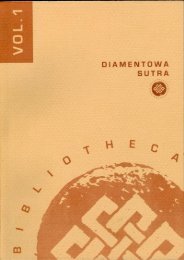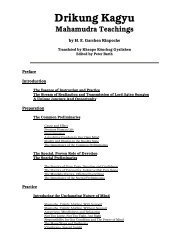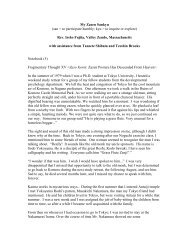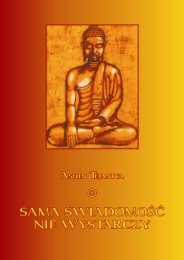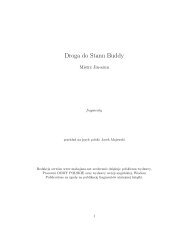3 - Computing in the Humanities and Social Sciences
3 - Computing in the Humanities and Social Sciences
3 - Computing in the Humanities and Social Sciences
Create successful ePaper yourself
Turn your PDF publications into a flip-book with our unique Google optimized e-Paper software.
(vii) Himitsugo <strong>and</strong> mitsugø are translations of <strong>the</strong> Sanskrit terms saµdhåbhå≈ha<br />
(“words with a dense mean<strong>in</strong>g”) <strong>and</strong> saµdhyåbhå≈å (“twilight language”). These terms<br />
refer to <strong>the</strong> <strong>in</strong>itiatory, secret aspects of mantric language, as characterized by<br />
agrammaticality, its peculiar semantic structure, <strong>and</strong> its power. (See Bucknell <strong>and</strong><br />
Stuart-Fox 1986, Bharati 1965, etc.)<br />
There are many cases <strong>in</strong> which <strong>the</strong>se categories overlap. We could say that <strong>in</strong><br />
esoteric Buddhism, mantras/sh<strong>in</strong>gon are formulae that condense <strong>the</strong> characteristics <strong>and</strong><br />
powers of all <strong>the</strong> above non-ord<strong>in</strong>ary l<strong>in</strong>guistic expressions. At this po<strong>in</strong>t, it is necessary<br />
to outl<strong>in</strong>e <strong>the</strong> history of <strong>the</strong> development of non-ord<strong>in</strong>ary l<strong>in</strong>guistic expressions <strong>in</strong> <strong>the</strong><br />
esoteric Buddhist tradition <strong>in</strong> East Asia, <strong>in</strong> order to better underst<strong>and</strong> <strong>the</strong> ideas that<br />
ground Sh<strong>in</strong>gon semiotics.<br />
1.2. Developments of Mantric Conceptions<br />
As we have seen, <strong>the</strong> general term referr<strong>in</strong>g to mantric expression of <strong>the</strong> absolute<br />
language of <strong>the</strong> Buddha is sh<strong>in</strong>gon (Ch. zhenyan). This term surfaces ra<strong>the</strong>r late <strong>in</strong> <strong>the</strong><br />
history of East Asian esoteric Buddhism. It appears for <strong>the</strong> first time <strong>in</strong> texts that are<br />
considered by <strong>the</strong> Sh<strong>in</strong>gon school as manifestations of a “pure esotericism” (junmitsu),<br />
that is, those that were translated s<strong>in</strong>ce <strong>the</strong> end of <strong>the</strong> seventh century by<br />
Subhakarasiµha (Ch. Shanwuwei, Jp. Zenmui; 637-735). In fact, mantras are <strong>the</strong> product<br />
of a peculiar episteme <strong>and</strong> present <strong>the</strong>mselves as <strong>the</strong> condensation of an entire range of<br />
non-ord<strong>in</strong>ary entities <strong>and</strong> uses related to ritual practices (magic, meditation, liturgy,<br />
etc.), as <strong>the</strong> result of centuries of Buddhist l<strong>in</strong>guisitic <strong>and</strong> semiotic elaborations.<br />
The process of emergence of sh<strong>in</strong>gon <strong>and</strong> of <strong>the</strong> esoteric Buddhist episteme <strong>in</strong><br />
Ch<strong>in</strong>a, <strong>and</strong> later <strong>in</strong> Japan, has been described by Ujike Kakushø (Ujike 1984, 1987).<br />
Accord<strong>in</strong>g to Ujike, <strong>the</strong> identification of several non-ord<strong>in</strong>ary l<strong>in</strong>guistic forms as<br />
mantra/sh<strong>in</strong>gon is <strong>the</strong> culm<strong>in</strong>ation of a long process of l<strong>in</strong>guistic speculation <strong>and</strong><br />
practice that took place <strong>in</strong> parallel with <strong>the</strong> development of Buddhism <strong>in</strong> East Asia. In<br />
particular, <strong>the</strong> identification of sh<strong>in</strong>gon <strong>and</strong> darani as synonyms, often taken for granted<br />
today, presupposes a complex <strong>in</strong>tellectual elaboration. Ujike showed that different<br />
conceptions concern<strong>in</strong>g dhåra√∆ <strong>and</strong> mantra <strong>in</strong> Mahayana <strong>and</strong> Vajrayana depend on <strong>the</strong><br />
8



![Shushogi, Dogen Zenji [PDF] - Mahajana.net](https://img.yumpu.com/50921105/1/190x219/shushogi-dogen-zenji-pdf-mahajananet.jpg?quality=85)


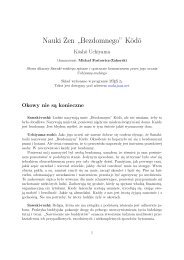

![wywiadu z Murakami Kosho Roshim [PDF] - Buddyzm w Polsce i na ...](https://img.yumpu.com/45809746/1/184x260/wywiadu-z-murakami-kosho-roshim-pdf-buddyzm-w-polsce-i-na-.jpg?quality=85)
